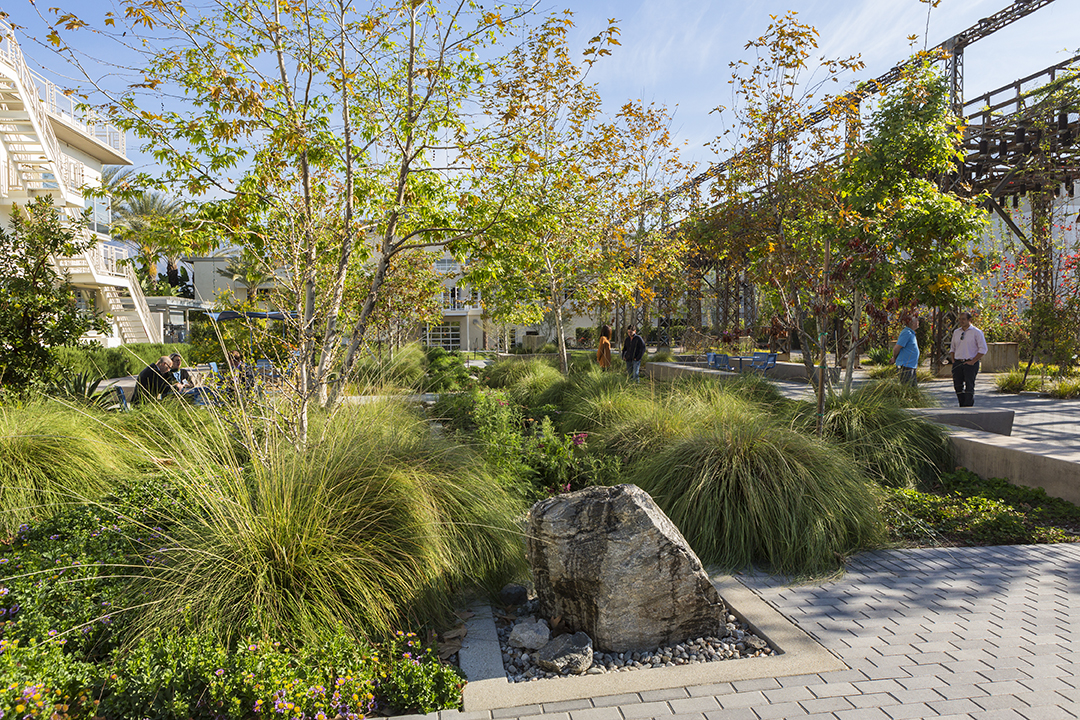Ecosystem services refer to the benefits that natural environments and biodiversity provide to humans. In landscape design, these services can be integrated to create sustainable, functional, and resilient outdoor spaces. Here's a breakdown of how, when, what, and in what way to use and quantify ecosystem services in landscape design:
1. What Ecosystem Services Can Be Integrated?
Regulating Services:
Trees and vegetation cool urban areas by providing shade and through evapotranspiration.Air Quality Improvement: Plants absorb pollutants like CO2, NO2, and particulate matter, improving the air quality.Stormwater Management: Green spaces and permeable surfaces absorb and manage rainwater, reducing runoff and flood risk.Carbon Sequestration: Plants and trees absorb CO2 and store carbon, mitigating climate change.
Provisioning Services:
Food Production: Urban farming, gardens, and community orchards provide food and improve food security.Water Supply: Water bodies and wetlands can enhance water availability and quality.
Cultural Services:
Aesthetic and Recreational Value: Green spaces contribute to human well-being by providing areas for recreation, relaxation, and social interaction.Biodiversity and Habitat Creation: Supporting diverse ecosystems encourages wildlife, creating habitat corridors that increase biodiversity.
Supporting Services:
Soil Formation and Fertility: Plants and trees contribute to soil health, prevent erosion, and support agriculture.Pollination: Designing with pollinator-friendly plants supports biodiversity and food production.
2. How and When to Integrate Ecosystem Services in Landscape Design?
Design Process:
Early Planning: Begin considering ecosystem services at the conceptual phase of a project. Understand the environmental context and desired ecosystem outcomes (e.g., reducing heat, managing stormwater).Site Analysis: Assess the natural systems of the site, including existing vegetation, water flow patterns, climate conditions, and biodiversity. This helps identify opportunities for incorporating services like carbon sequestration or stormwater management.Plant Selection: Choose species based on their ecological functions. Native, drought-tolerant plants are often the best for supporting multiple ecosystem services (shade, habitat, stormwater absorption).Functional Zoning: Design spaces with specific services in mind, such as bioswales for stormwater or green roofs for temperature regulation and air quality improvement.
Implementation:
Green Infrastructure: Use sustainable features like green roofs, permeable pavements, and rain gardens to manage water, reduce pollution, and increase cooling.Biodiversity Landscaping: Integrate habitat gardens, wildlife corridors, and pollinator pathways into urban or suburban designs to enhance biodiversity.
Long-Term Management:
Maintenance Plans: Develop plans for long-term monitoring and maintenance of ecosystem services, ensuring that features such as trees, gardens, and water management systems continue to function optimally.
3. How to Quantify Ecosystem Services in Landscape Design?
- i-Tree Tools:
i-Tree provides tools like i-Tree Eco, i-Tree Canopy, and i-Tree Landscape to quantify the ecosystem benefits of trees and green spaces. These tools calculate air pollution removal, carbon sequestration, stormwater interception, and more based on data input about plant species, size, and location.
- Monetary Valuation:
Ecosystem services can be monetized to demonstrate their economic value. For example, urban green space can be valued by estimating energy savings due to temperature regulation or the cost of avoided stormwater infrastructure. Tools like The Natural Capital Project and TESSA (Toolkit for Ecosystem Service Site-based Assessment) can help quantify and assign value to ecosystem services in specific locations.
- Carbon Sequestration Metrics:
Use standardized carbon calculators or tools like Carbon Footprint Analysis to estimate the amount of CO2 sequestered by trees, plants, and green spaces in a given area.
- Stormwater Benefits:
Calculate water retention capacity using tools like SWMM (Storm Water Management Model) or local guidelines to assess how well landscape elements (bioswales, green roofs) can reduce runoff and flooding.
- Biodiversity and Habitat Value:
Ecological surveys and biodiversity indices can be used to measure the variety of species supported by a landscape. Habitat value can be estimated based on the types of plants, their ability to support pollinators or wildlife, and the complexity of the ecosystem created.
Ecosystem Services: Further reading
4. In What Way Can Ecosystem Services Enhance Landscape Design?
Design for Resilience: Integrating ecosystem services ensures that landscapes are more adaptable to changing conditions (e.g., extreme weather, climate change). For example, designing green spaces to manage stormwater or provide cooling reduces a community’s vulnerability to floods and heatwaves.
Multi-Functional Design: Landscape designs that serve multiple ecosystem functions (like carbon sequestration, cooling, and stormwater management) provide both environmental and economic benefits. This holistic approach is more sustainable and can lower long-term costs.
Public Health Benefits: By incorporating ecosystem services like air purification, temperature regulation, and recreational green spaces, landscapes contribute to improved mental and physical health of communities.
Social and Economic Benefits: Ecosystem services can increase property values, attract businesses, and create jobs (e.g., in the green industry), while improving the overall quality of life in urban areas.
Integrating ecosystem services into landscape design offers both immediate and long-term benefits. Through strategic planning, plant selection, and design integration, landscapes can provide critical functions such as water management, climate resilience, and biodiversity support. By quantifying and valuing these services, designers, planners, and policymakers can ensure that landscapes are not just beautiful but also sustainable, functional, and ecologically beneficial for future generations.




No comments:
Post a Comment